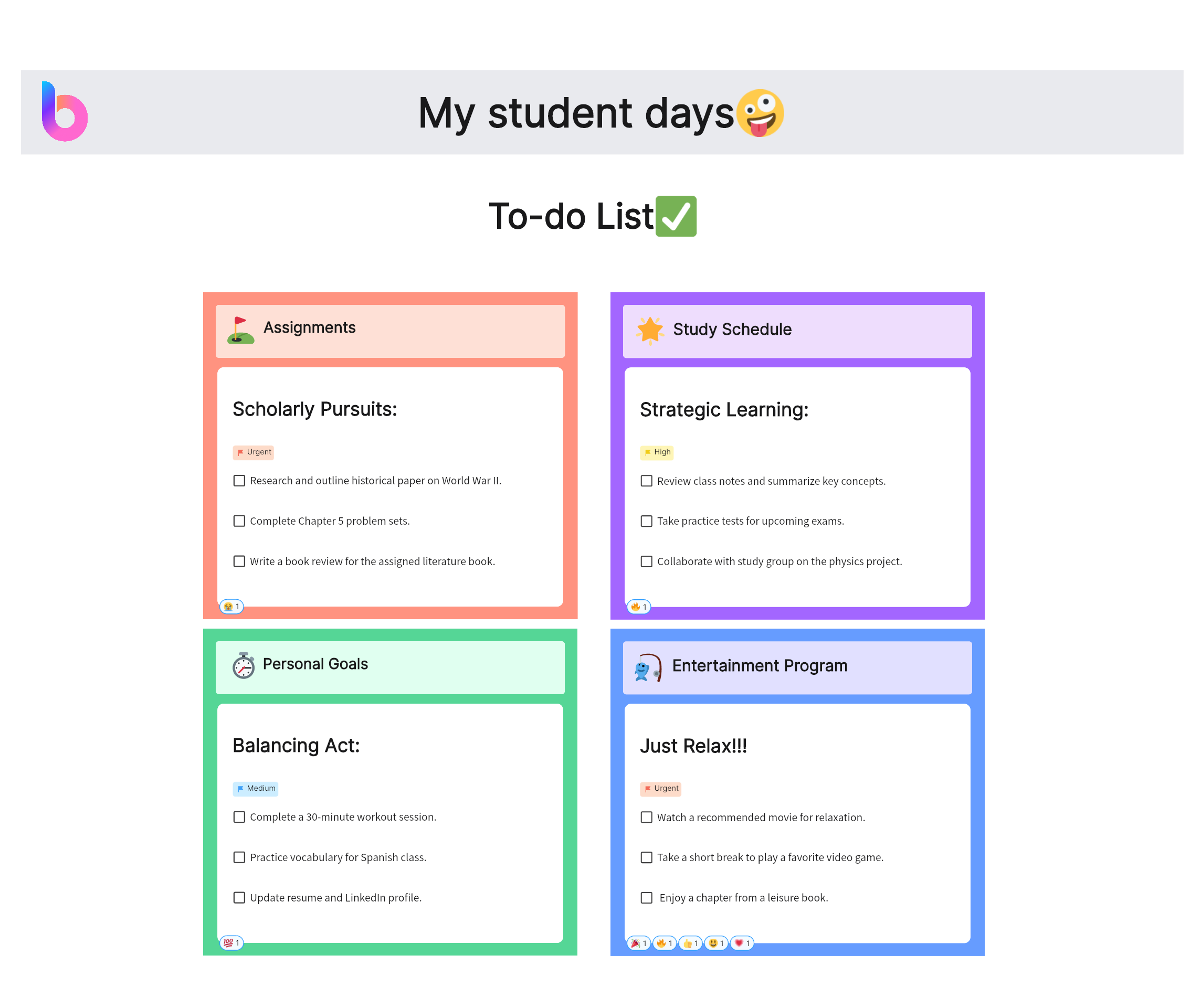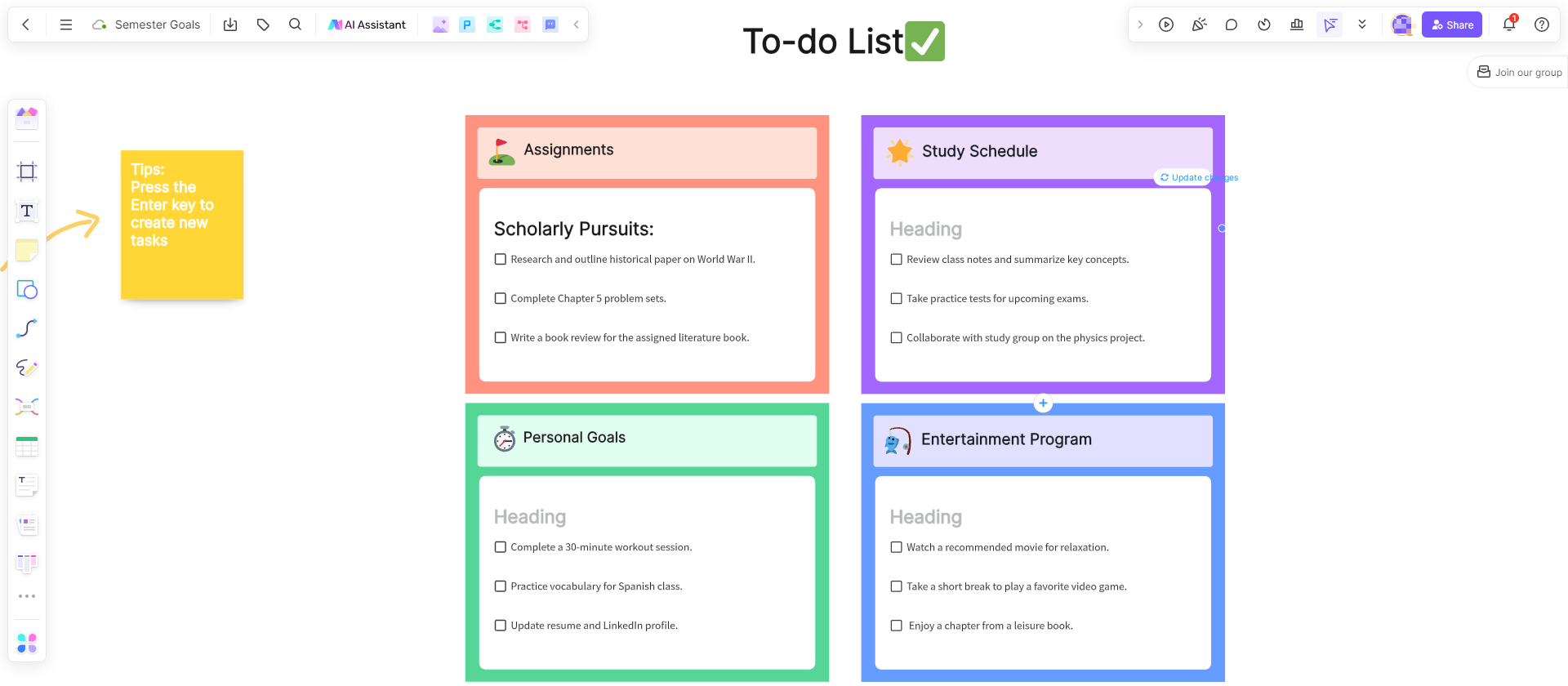Productivity and time management are key skills necessary for academic success. Among the myriad of tools and strategies, to-do lists hold a prominent place in a student's arsenal. Let's delve into the concept of a to-do list for students and uncover everything you need to know.
What Is a To-do List
A to-do list is a structured list of tasks that one needs to complete within a specific timeframe. It serves as a personal management tool, enabling users to organize and prioritize their tasks efficiently. To-do lists can be simple handwritten lists, sticky notes on a board, or more elaborate digital lists on dedicated task management platforms.

At its core, a to-do list transforms abstract responsibilities into tangible tasks, making them more manageable and less overwhelming. Each task on the list represents a concrete action that contributes towards the completion of a larger goal or project.
Why Is a To-do List for Students Necessary
For students juggling coursework, extra-curricular activities, part-time jobs, and social commitments, time management becomes a critical challenge. Here is where a to-do list becomes essential.
- Organization: A to-do list helps students organize their tasks based on subjects, assignments, deadlines, or importance. It offers a clear view of what needs to be done, reducing the risk of missing out on important tasks.
- Prioritization: Not all tasks are equally important or urgent. To-do lists enable students to prioritize their tasks based on factors like due date, effort required, and significance.
- Time Management: By breaking down larger projects into smaller tasks and allocating specific time slots for each, to-do lists help students manage their time effectively.
- Productivity: By providing a clear roadmap of tasks, to-do lists reduce decision fatigue and procrastination, enhancing overall productivity.
- Motivation and Satisfaction: Crossing off completed tasks from the list provides a sense of accomplishment and progress, which can be incredibly motivating.
A to-do list is an invaluable tool for students striving to balance academic and personal responsibilities. It enables them to stay organized, manage their time efficiently, and foster a sense of control over their tasks, contributing to their academic success and well-being.
When to Use a Student To-do List
A student to-do list is an essential organizational tool that can be used across numerous scenarios. Let's explore some situations where this tool proved most beneficial:
- Daily Tasks: Day-to-day academic responsibilities like attending classes, homework, reading assignments, and exam revision are ideally suited for a to-do list. They can be marked off upon completion, providing a sense of accomplishment and motivation.
- Project Planning: Larger academic projects or group assignments can be broken down into smaller, manageable tasks on the to-do list, making it easier to track progress and deadlines.
- Exam Preparation: A to-do list can act as a study planner during exam periods, helping students organize their revision schedule, manage stress, and ensure comprehensive coverage of all subjects.
- Long-term Goals: A student's to-do list can also include longer-term goals like preparing for college applications, scholarship submissions, or planning for internships.
What Should Be on a To-do List for Students
A student's to-do list should be comprehensive and well-structured, ensuring it covers all relevant tasks. Here are some key items to consider:
- Academic Tasks: Coursework-related tasks like homework, project work, studying for tests, online classes should be at the top of the list.
- Extracurricular Activities: This could include club meetings, sports practices, art classes, etc.
- Personal Tasks: Such as chores, shopping, personal projects, or hobbies should also be incorporated.
- Wellness Activities: Self-care tasks like meditation, exercise, and reading for pleasure are crucial for maintaining a healthy balance and should not be overlooked.
- Long-term Goals: Incorporate tasks that contribute towards achieving bigger goals like researching potential colleges, working on college essays, or preparing for standardized tests.
- Time Buffers: It’s important to leave gaps between tasks to account for unexpected delays and breaks.
Effective utilization of a student to-do list relies on understanding when to use it and what to include. By incorporating regular academic duties along with personal tasks and long-term goals, students can create a robust roadmap toward academic success and personal growth.
How to Create a To-do List for Students Using Boardmix
One key factor in effectively using a to-do list is the tool you choose for managing it. Boardmix, a robust task management platform, provides an intuitive and efficient solution. This part will show you how to create a to-do list for students using Boardmix.

The process of creating a to-do list on Boardmix is as easy as ABC. Here are the steps:
Sign up on Boardmix using an email address or Google account.

Navigate to the dashboard and click on the 'New board' button. You can name this board as per your need – for instance, 'Semester Goals', 'Math Homework', 'College Application Tracker', etc.

Within your board, you can create separate lists for different categories of tasks using the ready-made template or Kanban board. For example, 'Assignments', 'Study Schedule', 'Personal Goals', etc.

In each list, you can add specific tasks along with details such as task descriptions, due dates, priority levels, and labels.

Boardmix allows you to customize tasks with different colors, labels, and attachments. This feature is particularly useful in differentiating tasks and organizing them effectively.
If you're working on a group project or want to share your to-do list with others, you can invite them to your board via a sharing link or an email invitation.

You can set reminders for each task to ensure you never miss a deadline. As you complete tasks, mark them as done and see your progress in real-time.

Boardmix thus provides an efficient, flexible, and powerful platform for students to manage their academic workload. By organizing and tracking tasks, setting reminders, and visualizing progress, students can navigate their academic journey with confidence and ease, ultimately achieving their goals.
Why Is Boardmix the Best To-do List Tool for Students
In an increasingly digital era, students require tools that seamlessly blend with their lifestyles and needs. Boardmix, a leading task management tool, has emerged as the preferred choice among students. Let's delve into why Boardmix is the best to-do list tool for students.
- Ease of Use: Boardmix features a simple, intuitive interface. Creating boards, adding lists and tasks, setting deadlines, and tracking progress are all straightforward actions that require no technical expertise.
- Flexible and Adaptable: Boardmix is not rigid. Whether you are managing daily tasks, long-term projects, or semester-long goals, the tool adapts to your needs.
- Collaboration Features: Whether it's group projects or study groups, collaboration is central to a student's life. Boardmix supports real-time collaboration, allowing students to work together efficiently.
- Reminder and Notification System: Never miss a deadline with Boardmix's robust reminder and notification system. It ensures that important tasks are always at the forefront of your mind.
- Visual Progress Tracking: Visual representations in Boardmix allow you to gauge progress at a glance. Whether it's completed tasks or pending ones, it gives a clear picture of your productivity.
- Accessibility: Accessibility is key in a fast-paced student life. Boardmix can be accessed on any device – desktop, tablet, or mobile – enabling students to manage their tasks anywhere, anytime.
- Affordability: Last but not least, Boardmix offers cost-effective plans tailored for students, making it a pocket-friendly choice.
In conclusion, Boardmix shines as the perfect blend of functionality, simplicity, flexibility, and affordability, catering perfectly to a student's task management needs. By opting for Boardmix, students can maintain an organized academic life and improve their productivity manifold.








